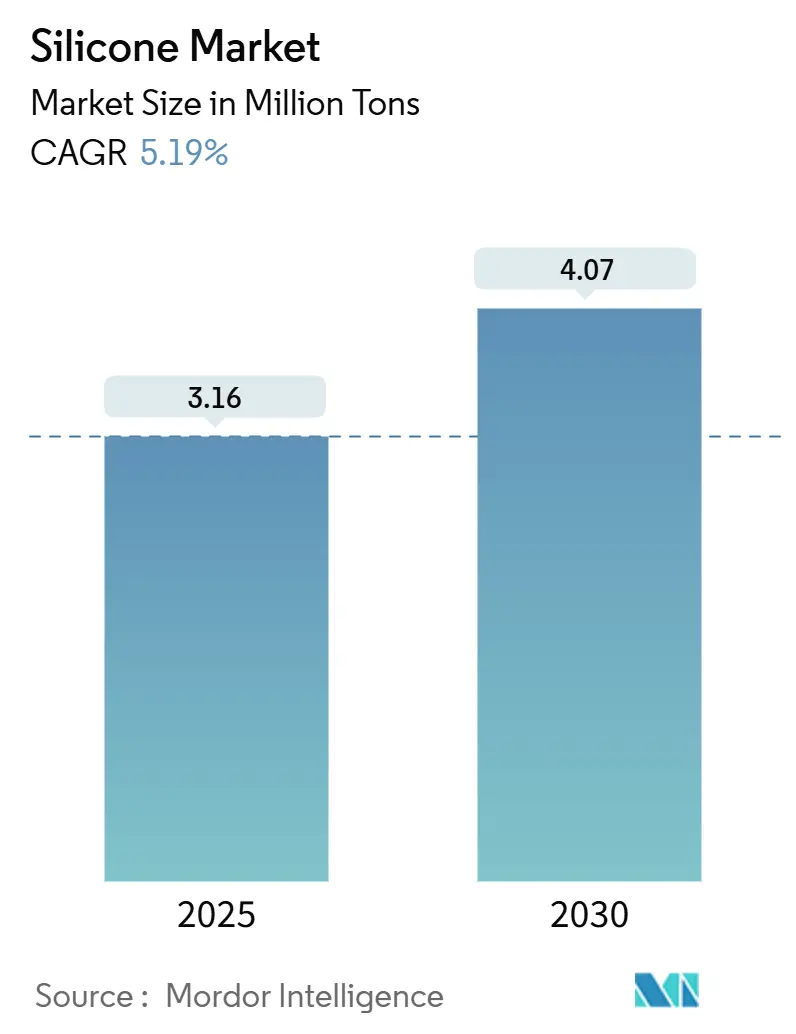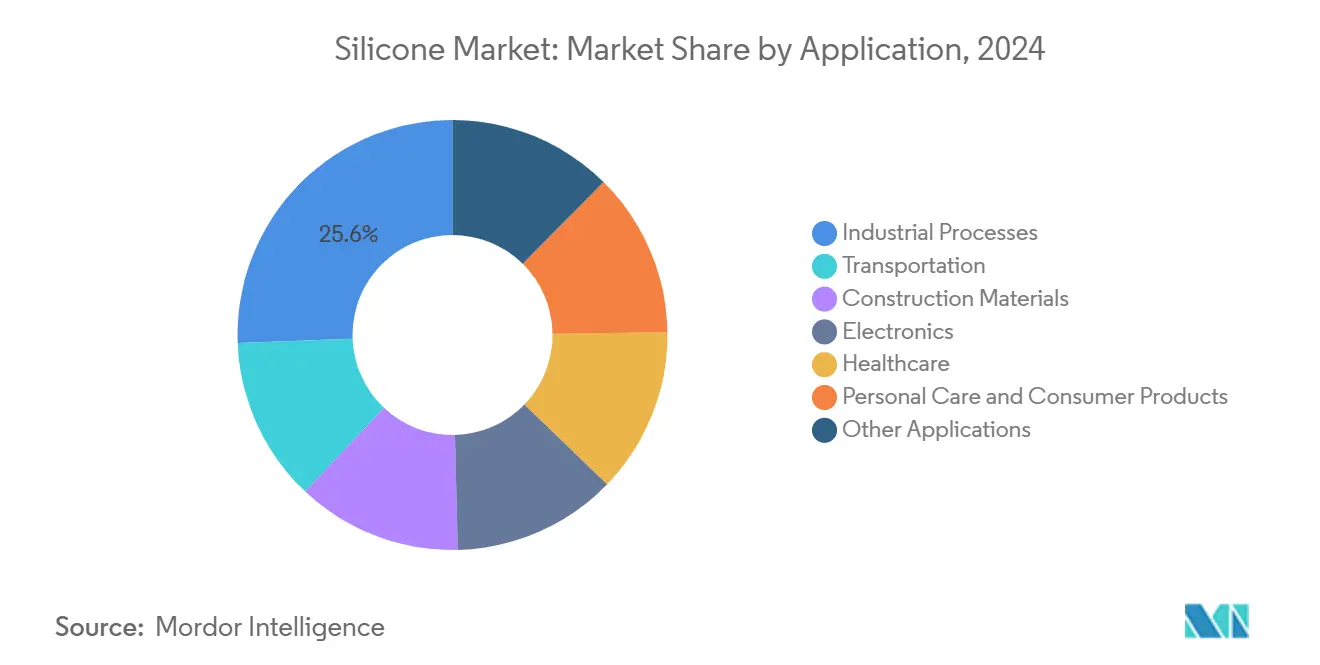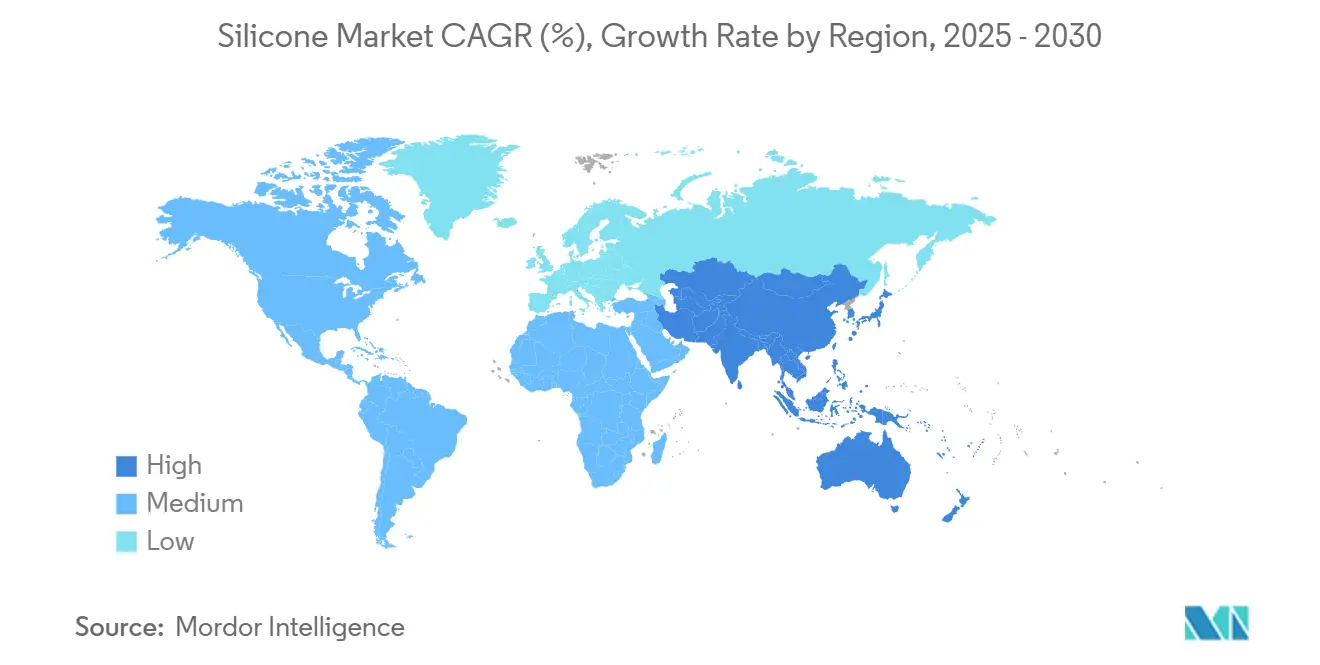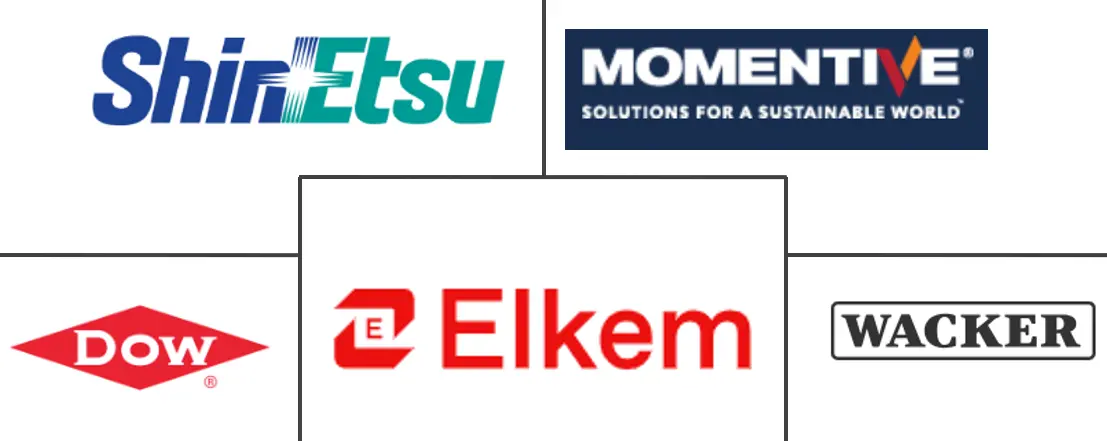
Silicone Market Analysis by Mordor Intelligence
The Silicone Market size is estimated at 3.16 million tons in 2025, and is expected to reach 4.07 million tons by 2030, at a CAGR of 5.19% during the forecast period (2025-2030). This measured expansion reflects the material’s entrenched role across mature end-uses while signaling rapid uptake in next-generation applications that demand higher performance and reliability, especially in electric mobility, renewable power, advanced electronics, and medical technology. Robust infrastructure spending in Asia-Pacific, the shift to battery-electric vehicles, and regulatory pushes for more durable, low-maintenance materials continue to underpin baseline growth. At the same time, specialty grades designed for thermal management, biocompatibility, and environmental compliance are unlocking price premiums that help producers protect margins from silicon-metal volatility. Competitive barriers remain rooted in integrated supply chains, proprietary formulations, and the qualification cycles required in safety-critical applications, all of which support a steady value-creation path for incumbents in the silicone industry.
Key Report Takeaways
- By form, elastomers captured 49.89% of the silicone market share in 2024, while the segment is projected to expand at a 5.40% CAGR through 2030.
- By application, industrial processes accounted for 25.58% of the silicone market size in 2024 and are forecast to advance at a 5.77% CAGR between 2025-2030.
- By geography, Asia-Pacific held 65.55% of the silicone industry share in 2024; the region is poised to grow at a 6.47% CAGR over the same period.
Global Silicone Market Trends and Insights
Driver Impact Analysis
| Drivers | (~) % Impact on CAGR Forecast | Geographic Relevance | Impact Timeline |
|---|---|---|---|
| Automotive and e-mobility applications | +1.2% | Global, concentration in China, Europe, North America | Medium term (2-4 years) |
| Healthcare and medical devices usage | +0.9% | Global, led by North America and Europe | Long term (≥ 4 years) |
| Power transmission and distribution grid demand | +0.7% | APAC core, spill-over to MEA and Latin America | Long term (≥ 4 years) |
| 5G base-station thermal materials | +0.6% | Global, early deployment in APAC and North America | Short term (≤ 2 years) |
| LSR in wearable medical sensors | +0.4% | North America and EU, expanding to APAC | Medium term (2-4 years) |
| Source: Mordor Intelligence | |||
Rising Applications in Automotive and E-mobility
Electric-vehicle (EV) adoption is multiplying the use of silicone by widening the performance gap versus traditional elastomers. Battery-pack sealing, thermal gap-pads, and high-voltage cable insulation collectively add close to 15 kg of silicone per Tesla Model Y, roughly triple that of an internal-combustion sedan. European OEMs now favor liquid-silicone rubber (LSR) for under-hood parts that must withstand new glycol-free coolants at 150 °C. Chinese EV makers have begun dual-sourcing high-consistency rubber and addition-cure LSR to buffer silicon-metal price swings, encouraging integrated suppliers to lock in long-term contracts. As stringent zero-emission targets phase in, every major automaker is redesigning gasketing, potting, and interface materials, creating an enduring pull for advanced grades across the silicone industry.
Increasing Usage in Healthcare and Medical Devices
Medical-grade silicones must clear USP Class VI and ISO 10993 testing, a protocol that can extend new-product roadmaps by up to 24 months, thereby shielding incumbent suppliers from short-cycle pricing pressure. Wearable glucose monitors, cardiac leads, and neuromodulation implants all hinge on LSR’s hypoallergenic profile and stable modulus at body temperature. Hospitals value the polymer’s sterilization compatibility with gamma, steam, and e-beam methods, which supports lean re-use strategies in minimally invasive tools. Digitization of care—particularly remote monitoring—has sparked OEM demand for translucent, optically clear silicone films that integrate optical sensors without compromising flex-life. Collectively, these factors cement healthcare as a margin-accretive pillar of the silicone industry.
Demand from Power Transmission and Distribution Grids
Upgrades to extra-high-voltage lines underscore silicone’s hydrophobicity, especially in environments where ceramic insulators suffer flashover. India alone will need roughly 50,000 tons of silicone-rubber insulators through 2030 to hit its grid-reliability targets[1]U.S. Geological Survey, “Mineral Commodity Summaries 2025,” USGS.GOV. Offshore wind farms in Korea and Taiwan further rely on silicone sealants to endure salt spray and ultraviolet exposure, while Latin American utilities specify room-temperature-vulcanizing (RTV) coatings for desert transmission corridors challenged by airborne dust. As climate events amplify outage costs, utilities view the higher upfront spending on silicone components as a justifiable hedge against downtime, reinforcing long-tail demand within the silicone industry.
5G Base-station Thermal Interface Materials
Radio units operating above 24 GHz dissipate more than 200 W/cm², a heat flux that conventional grease fails to manage. Silicone-based thermal pads featuring 3.0 W/mK conductivity meet carrier specifications for gap thicknesses below 200 μm, enabling miniaturized radio-frequency front ends. China exceeded 2.3 million 5G macro sites in 2024, prompting synchronized procurement cycles that stress specialty compound capacity. North American and European operators add complexity by requiring low volatile-siloxane grades to satisfy local emissions rules. Edge-computing nodes now replicate these thermal demands, widening the addressable portion of the silicone market across telecom infrastructure.
Restraint Impact Analysis
| Restraints | (~) % Impact on CAGR Forecast | Geographic Relevance | Impact Timeline |
|---|---|---|---|
| Silicon-metal price volatility and bottlenecks | -0.8% | Global, acute in Asia-Pacific | Short term (≤ 2 years) |
| Stringent siloxane-emission regulations | -0.5% | Europe and North America, spreading globally | Medium term (2-4 years) |
| Competition from fluoropolymers and plastics | -0.3% | Global, application-specific | Long term (≥ 4 years) |
| Source: Mordor Intelligence | |||
Volatile Silicon-metal Prices and Supply Bottlenecks
Spot silicon-metal swung between USD 1,800-3,200/ton in 2024 on energy-price gyrations and trade measures, squeezing margin profiles across integrated and merchant producers alike. China supplies nearly 68% of global output, so provincial power rationing immediately reverberates through downstream silicone volumes and pricing. While long-term offtake contracts provide partial insulation, most renew annually, leaving buyers exposed to structural energy-cost inflation. Pilot recycling of semiconductor kerf scrap yields less than 5% of chemical-grade demand, offering only modest relief. Until diversified, low-carbon smelting gains scale, raw-material turbulence will shadow short-term forecasts for the silicone industry.
Stringent Siloxane Emission Regulations
The European Chemicals Agency’s push to restrict D4, D5, and D6 cyclics under REACH obliges producers to re-engineer fluids and personal-care intermediates or face market exit. Reformulation and testing can add more than USD 500,000 per SKU, not counting the 18-month sell-through grace period[2]European Commission DG Environment, “Ship hull anti-fouling—are silicone-based coatings a viable, sustainable alternative to toxic, copper-based coatings in the Baltic Sea?” ENVIRONMENT.EC.EUROPA.EU . Similar draft rules in Canada and selected U.S. states foreshadow a wider compliance footprint. Although the hurdle favors incumbents with strong regulatory teams, it also diverts research and development resources away from growth programs. On the upside, the drive accelerates next-generation linear-chain chemistries, opening differentiated niches within the silicone industry for low-VOC and biodegradable solutions.
Segment Analysis
By Form: Elastomers Lead Innovation and Volume Growth
Elastomers controlled 49.89% of the silicone market share in 2024 and are forecast to grow at a 5.40% CAGR through 2030. Within this group, liquid-silicone rubber for EV connectors and medical catheters captures the lion’s share of incremental tonnage, while high-consistency rubber secures repeat orders in industrial gasketing. LSR’s platinum-cure chemistry shortens cycle times, allowing multi-cavity molds that scale efficiently for high-volume parts. Meanwhile, room-temperature-vulcanizing (RTV) grades strength-en sealant franchises in construction rehabilitation, feeding consistent demand regardless of macro-cycles. Collectively, these attributes make elastomers the pivotal innovation hub in the silicone industry.
Fluids rank second in volume, anchored by their role as process aids, lubricants, and personal-care emollients. Although impending siloxane limits challenge commodity cyclics, linear-chain fluids with lower volatility are gaining traction and help offset losses. Resins continue to deliver niche growth as protective encapsulants in power electronics and solar panels, where their thermal stability outperforms epoxy analogs. Specialty formats—gels, foams, and powders—round out the portfolio, supplying advanced textiles, 3-D printing resins, and additive-manufacturing binders. Even as boundaries blur, the cumulative developments sustain a balanced contribution to the silicone market size.

Note: Segment shares of all individual segments available upon report purchase
By Application: Industrial Processes Drive Market Evolution
Industrial processes accounted for a 25.58% slice of the silicone market size in 2024 and are on track for a 5.77% CAGR by 2030. Chemical and pharmaceutical plants rely on silicone antifoams to secure batch-purity and throughput, an especially salient factor as biologics and high-potency actives proliferate. Food processors adopt FDA-compliant silicone lubricants that resist steam cleaning cycles, boosting equipment uptime and worker safety. These cross-segment synergies reinforce industrial processes as the cornerstone of demand within the silicone industry.
Transportation applications follow closely, energized by EV battery sealing, lightweight glazing, and high-temperature hose assemblies. Construction retains a solid base as stricter building codes specify silicone weather-seals for air-infiltration control. Electronics surge on the back of 5G infrastructure, solid-state lidar, and wearables requiring miniaturized thermal interface layers. Healthcare maintains double-digit unit growth through implantables and disposables that must withstand sterilization. Personal-care volumes plateau in Europe due to cyclic restrictions, but find a lift in Asia via reformulated shampoos and color cosmetics. This diversity of pull factors insulates the silicone industry from single-sector shocks, supporting its durable growth profile.

Note: Segment shares of all individual segments available upon report purchase
Geography Analysis
Asia-Pacific wielded 65.55% of the global silicone market share in 2024, propelled by integrated supply chains and prolific downstream manufacturing. China features fully backward-integrated players that couple local silicon-metal furnaces to elastomer finishing plants, enabling cost competitiveness and rapid scale-up.
North America remains a technology vanguard, where aerospace, advanced automotive, and biomedical device makers impose stringent material specifications. The CHIPS Act catalyzes domestic semiconductor production, triggering new orders for ultra-low-ionic contamination silicone encapsulants. Wind-turbine repowering in the Midwest and solar-farm expansions in the Southwest anchor demand for high-durability sealants, while the U.S. Food and Drug Administration’s predictable pathway for LSR components bolsters healthcare volumes. These trends, paired with active research into bio-based siloxane precursors, position the region as an innovation driver in the silicone industry.
Europe secures its role through specialty applications and regulatory leadership. Producers invest in closed-loop depolymerization units that convert spent elastomer scrap into cyclic monomers, aligning with the bloc’s circular-economy vision. Automotive electrification mandates energize demand for high-temperature, low-bleed thermal pads, while offshore-wind build-outs in the North Sea necessitate robust resins for nacelle encapsulation. Although REACH obligations elevate compliance costs, they also create barriers that temper direct price competition, sustaining value density across the European silicone industry.

Competitive Landscape
The silicone industry demonstrates moderate fragmentation. Dow and Shin-Etsu maintain parallel research and development footprints, channeling 3-5% of sales into differentiated formulations for EV battery packs, 5G modules, and drug-delivery devices. Vertical integration into silicon-metal smelting buffers these leaders from raw-material spikes, whereas mid-tier formulators often rely on spot purchases, constricting margins during price surges. Patent activity now gravitates toward self-healing elastomers, high-refractive-index optical encapsulants, and chemically recycled siloxane feedstocks, signaling where the next competitive frontiers will emerge. Sustainability credentials are becoming formal bid requirements, especially in Europe, nudging suppliers to certify ISO 14001 systems and disclose life-cycle assessments.
Silicone Industry Leaders
-
Wacker Chemie AG
-
Dow
-
Shin-Etsu Chemical Co. Ltd
-
Elkem ASA
-
Momentive
- *Disclaimer: Major Players sorted in no particular order

Recent Industry Developments
- June 2025: WACKER introduced POWERSIL 1900 A/B, a two-component high-consistency rubber that streamlines spiral-extrusion production of composite insulators.
- May 2025: Shin-Etsu Chemical launched KF-6070W water-soluble silicone wax and KSG-16-SF/KSG-19-PF elastomer gels to enhance light-diffusion in personal-care formulations.
Global Silicone Market Report Scope
Silicone is a synthetic polymer of silicon, oxygen, carbon, and hydrogen atoms. It is known for its versatility, durability, and resistance to extreme temperatures, chemicals, and weathering. Silicone materials can be found in various forms, including fluids, rubbers, resins, and gels, and are used in a wide range of applications, such as sealants, adhesives, lubricants, and consumer products.
The silicone market is segmented by form, end user, and geography. Based on form, the market is segmented into elastomers and fluids. By end users, the market is segmented into transportation, construction materials, electronics, healthcare, industrial processes, personal care and consumer products, and other end users (textile and coatings). The report also covers the market sizes and forecasts for silicone in 27 countries across major regions. For each segment, the market sizing and forecasts are done based on volume (tons).
| Fluids |
| Elastomers |
| Resins |
| Others |
| Transportation |
| Construction Materials |
| Electronics |
| Healthcare |
| Industrial Processes |
| Personal Care and Consumer Products |
| Other Applications |
| Asia-Pacific | China |
| India | |
| Japan | |
| South Korea | |
| Thailand | |
| Malaysia | |
| Indonesia | |
| Vietnam | |
| Rest of Asia-Pacific | |
| North America | United States |
| Canada | |
| Mexico | |
| Europe | Germany |
| United Kingdom | |
| France | |
| Italy | |
| Spain | |
| Russia | |
| Turkey | |
| Nordics | |
| Rest of Europe | |
| South America | Brazil |
| Argentina | |
| Colombia | |
| Rest of South America | |
| Middle-East and Africa | Saudi Arabia |
| South Africa | |
| Nigeria | |
| Egypt | |
| Qatar | |
| United Arab Emirates | |
| Rest of Middle-East and Africa |
| By Form | Fluids | |
| Elastomers | ||
| Resins | ||
| Others | ||
| By Application | Transportation | |
| Construction Materials | ||
| Electronics | ||
| Healthcare | ||
| Industrial Processes | ||
| Personal Care and Consumer Products | ||
| Other Applications | ||
| Geography | Asia-Pacific | China |
| India | ||
| Japan | ||
| South Korea | ||
| Thailand | ||
| Malaysia | ||
| Indonesia | ||
| Vietnam | ||
| Rest of Asia-Pacific | ||
| North America | United States | |
| Canada | ||
| Mexico | ||
| Europe | Germany | |
| United Kingdom | ||
| France | ||
| Italy | ||
| Spain | ||
| Russia | ||
| Turkey | ||
| Nordics | ||
| Rest of Europe | ||
| South America | Brazil | |
| Argentina | ||
| Colombia | ||
| Rest of South America | ||
| Middle-East and Africa | Saudi Arabia | |
| South Africa | ||
| Nigeria | ||
| Egypt | ||
| Qatar | ||
| United Arab Emirates | ||
| Rest of Middle-East and Africa | ||
Key Questions Answered in the Report
How large is the silicone industry in 2025 and how fast is it growing?
The silicone market size stands at 3.16 million tons in 2025 and is projected to post a 5.19% CAGR, reaching 4.07 million tons by 2030.
Which form in silicone industry segment commands the highest share?
Elastomers lead with 49.89% of 2024 volume thanks to broad uptake in EVs, medical devices, and construction sealants.
Why is Asia-Pacific so dominant?
The region houses integrated supply chains, large electronics and automotive bases, and captures 65.55% of 2024 demand while expanding at a 6.47% CAGR.
What is driving silicone demand in electric vehicles?
Battery-pack sealing, thermal gap-pads, and high-voltage insulation collectively triple silicone usage per EV versus traditional cars.
How are regulations affecting silicone formulations?
Proposed REACH limits on cyclic siloxanes force reformulation toward low-volatility linear silicones, raising compliance costs but opening opportunities for greener grades.
Page last updated on:



